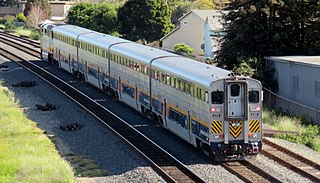
The San Joaquins is a passenger train service operated by Amtrak in California's San Joaquin Valley. Six daily round trips run between its southern terminus at Bakersfield and Stockton, with onward service to Sacramento and Oakland.

California High-Speed Rail is an American publicly funded high-speed rail system being developed in California. Overseen by the California High-Speed Rail Authority, it was authorized by the 2008 statewide ballot proposal Proposition 1A. It is intended to reduce travel times in the state, particularly between the major urban areas of the San Francisco Bay Area in the north and Greater Los Angeles in the south. The system is also intended to reduce pollution and carbon emissions, ease highway and air traffic congestion, and boost the state's economy, particularly in the Central Valley region.

Amtrak California is a brand name used by the California Department of Transportation (Caltrans) Division of Rail for three state-supported Amtrak regional rail routes in California – the Capitol Corridor, the Pacific Surfliner, and the San Joaquins – and their associated connecting network of Amtrak Thruway transportation services.

Central California is generally thought of as the middle third of the U.S. state, of California, north of Southern California, which includes Los Angeles, and south of Northern California, which includes San Francisco. It includes the northern portion of the San Joaquin Valley, part of the Central Coast, the central hills of the California Coast Ranges and the foothills and mountain areas of the central Sierra Nevada.

Richmond station is an Amtrak intercity rail and Bay Area Rapid Transit (BART) station located in downtown Richmond, California. Richmond is the north terminus of BART service on the Orange Line and Red Line; it is a stop for Amtrak's Capitol Corridor, San Joaquins, and California Zephyr routes. The accessible station has one island platform for the two BART tracks, with a second island platform serving two of the three tracks of the Union Pacific Railroad Martinez Subdivision for Amtrak trains. It is one of two transfer points between BART and Amtrak, along with Oakland Coliseum station.

The San Joaquin Valley Railroad is one of several short line railroad companies and is part of the Western Region Division of Genesee & Wyoming Inc. It operates over about 371 miles (597 km) of owned or leased track primarily on several lines in California's Central Valley/San Joaquin Valley around Fresno and Bakersfield. The SJVR has trackage rights over Union Pacific between Fresno, Goshen, Famoso, Bakersfield and Algoso. The SJVR also operated for the Tulare Valley Railroad (TVRR) from Calwa to Corcoran and Famoso.

Emeryville station is an Amtrak station in Emeryville, California, United States. The station is served by the California Zephyr, Capitol Corridor, Coast Starlight, and San Joaquins. The station is the primary connection point for Amtrak Thruway buses serving San Francisco.
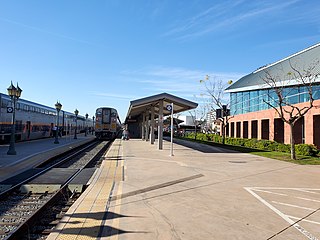
Bakersfield station is an intermodal facility in Bakersfield, California. It is the southern terminus of Amtrak California's San Joaquins route, with Amtrak Thruway buses continuing to Amtrak stations and bus stops throughout Southern California and Nevada. The station opened with a celebration on July 4, 2000. It contains an 8,300-square-foot (770 m2) train station with two platforms and three tracks, as well as a 17-bay bus station.

Martinez station is an Amtrak passenger train station in Martinez, California, United States. Located at the west end of downtown Martinez, the station has one side platform and one island platform, which serve three of the four tracks of the Union Pacific Railroad Martinez Subdivision. It is served by the daily California Zephyr and Coast Starlight long-distance trains, five daily round trips of the San Joaquin corridor service, and fifteen daily round trips of the Capitol Corridor service. Martinez is also served by Amtrak Thruway buses plus County Connection, Tri-Delta Transit, and WestCAT local buses.
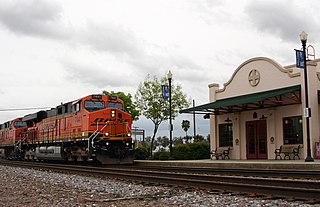
Corcoran station is an Amtrak train station in Corcoran, California, United States.

The Santa Fe Passenger Depot, also known as Fresno station, is an historic railroad station and transportation hub in downtown Fresno, California. It is served by San Joaquins inter-city passenger trains, Greyhound inter-city buses, and regional transit services including Fresno Area Express and the Fresno County Rural Transit Agency.
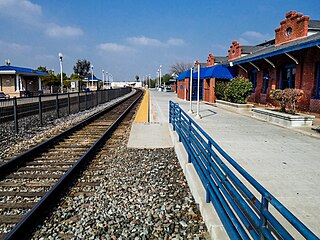
Hanford station is a train station in Hanford, California served by Amtrak. The station also services the larger city of Visalia, California, 20 miles (32 km) to the east.

Wasco station is an Amtrak station on the San Joaquin located in Wasco, California, United States. The station has one platform on the west side of a single track.

The Yosemite Valley Railroad (YVRR) was a short-line railroad that operated in California from 1907 to 1945, providing a new mode of travel and tourism for the region. It ran from Merced to the Yosemite National Park, but it did not extend to Yosemite Valley itself, as railroad construction was prohibited in the National Parks. Tourists would disembark at the park boundary in El Portal, California and stay overnight at the Hotel Del Portal before taking a stagecoach to Yosemite Valley.

The Yosemite Area Regional Transportation System (YARTS) is a public transit bus line based in Merced, California. YARTS provides scheduled fixed route service between Yosemite National Park and gateway communities. Service operates year-round on Highway 140, providing access to Merced and Mariposa counties. During the peak summer months, additional service is added along Highway 120 providing access to Tuolumne County, Highway 41 providing access to Fresno and Madera counties, and eastern Highway 120/US 395 providing access to Mono County.

Kern County’s transportation system was quoted as the “unseen industry.” Located at the southern end of the San Joaquin Valley, the county is at a prime location to ship goods west to the central coast, south to ports in Los Angeles, and east to corridors that connect to the rest of the country. It is also on major corridors that link to all northern points.
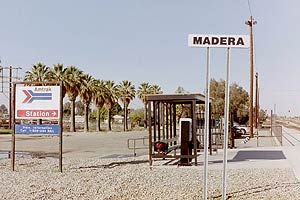
Storey was an unstaffed train station located in the unincorporated community of Storey, and about 1 mile (1.6 km) southeast of the Fresno River, in Madera County, California, United States. Just prior to its closure in November 2010 and replacement by the new Madera station, this station was served by Amtrak's San Joaquin. Prior to Amtrak, this station was also previously served by Atchison, Topeka and Santa Fe Railroad's (ATSF) San Francisco Chief and its Oakland-Barstow Line.
Merced station is a proposed California High-Speed Rail station in Merced, California, located in Downtown Merced. The environmentally approved site is on Martin Luther King Jr. Way near the interchange with Route 99/59, placing it about 7 blocks south from the existing Merced Amtrak station. The station was initially intended to be the northern terminus of the system's Initial Construction Segment. As of April 2022 the California High-Speed Rail Authority is studying an alternative location proposed by the City of Merced and other stakeholders, 8 blocks to the west-northwest along 15th Street, between O Street and R Street. The high-speed rail line will run on the south side of the Union Pacific Railroad right-of-way at these locations.
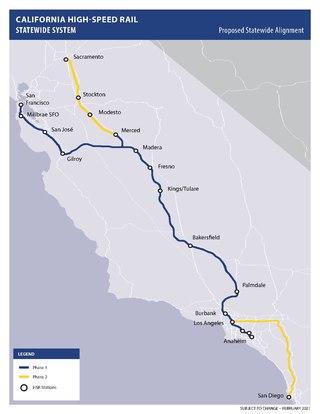
The California High-Speed Rail system will be built in two major phases. Phase I, about 520 miles (840 km) long using high-speed rail through the Central Valley, will connect San Francisco to Los Angeles. In Phase 2, the route will be extended in the Central Valley north to Sacramento, and from east through the Inland Empire and then south to San Diego. The total system length will be about 800 miles (1,300 km) long. Phase 2 currently has no timeline for completion.

In addition to the direct reduction in travel times the HSR project will produce, there are also economic and environmental impacts of the high-speed rail system. These were also specifically noted in Proposition 1A at the time the project sought authorization from the voters of the state in 2008. The anticipated benefits apply both generally to the state overall, as well as to the regions the train will pass through, and to the areas immediately around the train stations.






















